剑桥国际少儿英语Kid’s Box 5 教学大纲3-5单元
- 格式:doc
- 大小:32.00 KB
- 文档页数:2
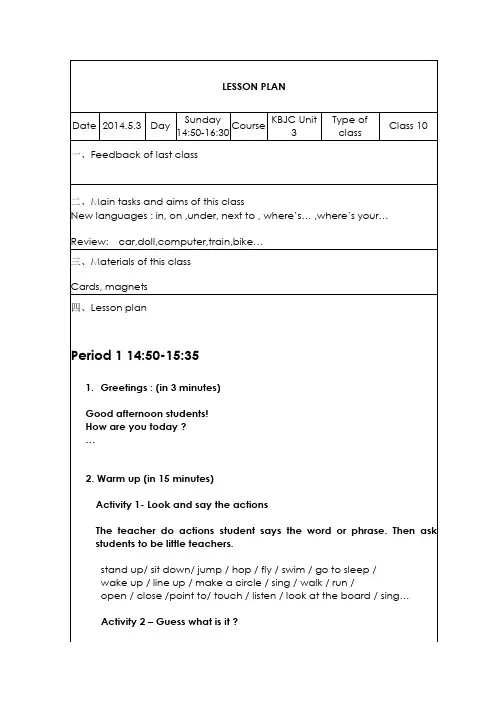
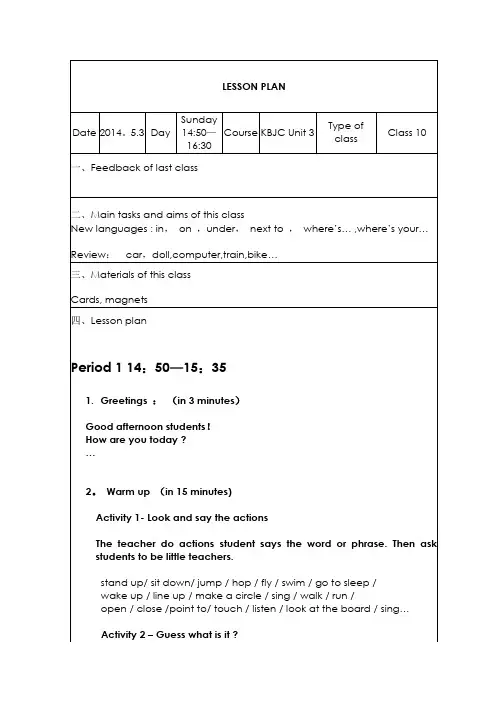
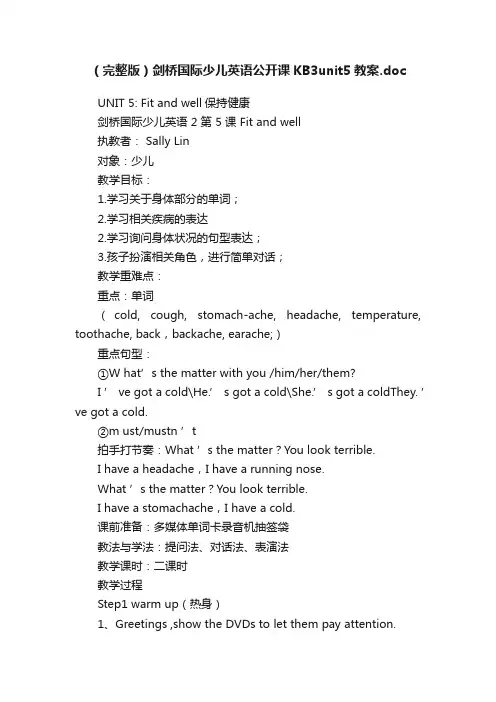
(完整版)剑桥国际少儿英语公开课KB3unit5教案.docUNIT 5: Fit and well保持健康剑桥国际少儿英语 2 第 5 课 Fit and well执教者: Sally Lin对象:少儿教学目标:1.学习关于身体部分的单词;2.学习相关疾病的表达2.学习询问身体状况的句型表达;3.孩子扮演相关角色,进行简单对话;教学重难点:重点:单词(cold, cough, stomach-ache, headache, temperature, toothache, back,backache, earache;)重点句型:①W hat’s the matter with you /him/her/them?I ’ ve got a cold\He.’ s got a cold\She.’ s got a coldThey. ’ ve got a cold.②m ust/mustn ’t拍手打节奏:What ’s the ma tter?You look terrible.I have a headache,I have a running nose.What ’s the matter?You look terrible.I have a stomachache,I have a cold.课前准备:多媒体单词卡录音机抽签袋教法与学法:提问法、对话法、表演法教学课时:二课时教学过程Step1 warm up(热身)1、Greetings ,show the DVDs to let them pay attention.2、show the picture of body part;3. Do the exercise to let Ss review the body parts and lead in new words;Step2 Lead in(入)Use picture lead in words(cold, cough, stomach-ache, headache, temperature, toothache, back, backache, earache;)T: Boys and girls , can you guess,what’sthe matter with me? (point at the nose)S1: cough..Step 3 presentation and practice (呈与操)1.listen to the song,and do the according actions.Ss imitate to do.2.Game Time(抽签让一位学生上台进行表演,让其他学生猜单词)3.Set up some situations to ask Ss how to deal with some problem...Step4 Consolidation(复巩固)1 .Listen to the tape,and do the according action to practice newWords and sentence again;2.ASK TIME. 再次提问各小组学生,看谁回答的又准确又好;Step5Home work(作)1.学生回家后参家或家人,假他身体状况,并制作5句以上;2.Step6 Blackboard design(板 )Unit 5Fit and wellTom Jenny kevin Amy10101010。
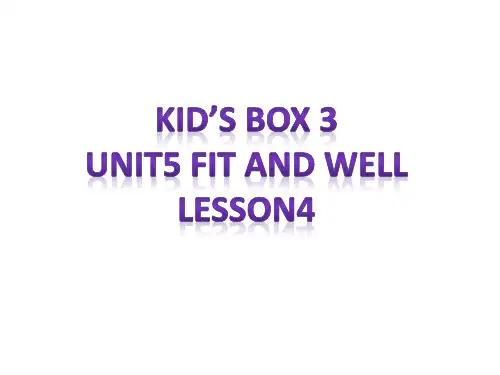
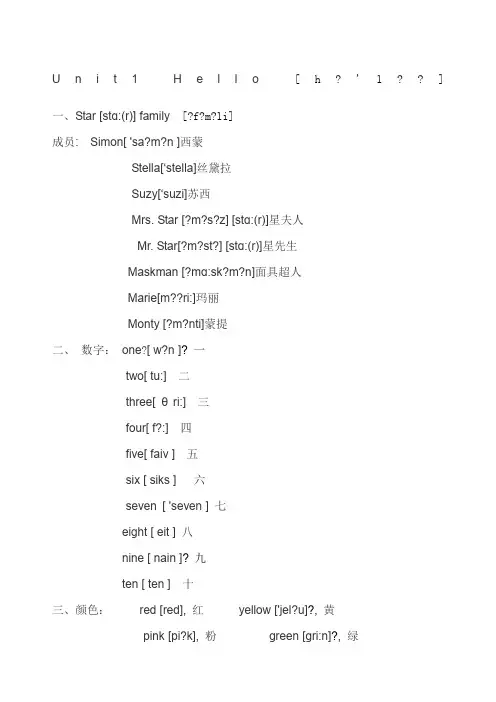
U n i t1H e l l o[h?'l??]一、Star [stɑ:(r)] family [?f?m?li]成员: Simon[ 'sa?m?n ]西蒙Stella[‘stella]丝黛拉Suzy[‘suzi]苏西Mrs. Star [?m?s?z][stɑ:(r)]星夫人Mr. Star[?m?st?] [stɑ:(r)]星先生Maskman [?mɑ:sk?m?n]面具超人Marie[m??ri:]玛丽Monty [?m?nti]蒙提二、数字:one?[ w?n ]? 一two[ tu:] 二three[ θri:] 三four[ f?:] 四five[ faiv ] 五six [ siks ] 六seven[ 'seven ] 七eight [ eit ] 八nine [ nain ]? 九ten [ ten ] 十三、颜色:red [red], 红yellow ['jel?u]?, 黄pink [pi?k], 粉green [gri:n]?, 绿orange ['?rind?], 橙purple ['p?:p?l], 紫blue [blu:]蓝rainbow [?re?nb??], 彩虹Sentences:重点句子:(对话要求学生听懂并回答即可)A: What’s your name?你叫什么名字?B: I am Meera. 我叫Meera。
A: How old are you ?你几岁了?B: I am 7. 我7岁。
A: what color is it ?这是什么颜色?B: It’s red. 红色。
*补充语言:stand up, 起立sit down,请坐close the door, 关门Open the door 开门歌曲Red and yellow and pink and green, orange and purple and blue.I can sing a rainbow, sing a rainbow, sing a rainbow to you.Unit2 My school 我的学校单词:school[sku:l]学校table[?te?bl] 桌子book[b?k], 书chair[t?e?(r)], 椅子pen[pen], 钢笔pencil[?pensl], 铅笔bag[b?g], 书包he[hi:], 他she[?i:], 她friend[frend], 朋友boy[b??], 男孩girl [g?:l] 女孩重点句子:(对话要求学生能够听懂并回答即可。
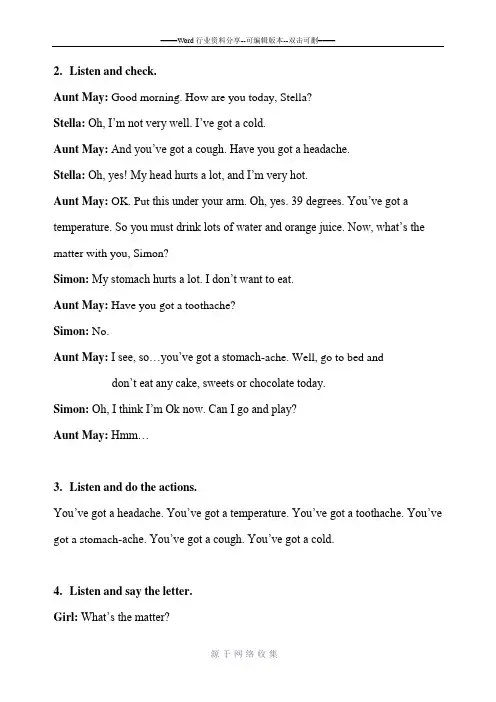
2.Listen and check.Aunt May: Good morning. How are you today, Stella?Stella:Oh, I’m not very well. I’ve got a cold.Aunt May: And you’ve got a cough. Have you got a headache.Stella:Oh, yes! My head hurts a lot, and I’m very hot.Aunt May: OK. Put this under your arm. Oh, yes. 39 degrees. You’ve got a temperature. So you must drink lots of water and orange juice. Now, what’s the matter with you, Simon?Simon: My stomach hurts a lot. I don’t want to eat.Aunt May: Have you got a toothache?Simon: No.Aunt May:I see, so…you’ve got a stomach-ache. Well, go to bed anddon’t eat any cake, sweets or chocolate today.Simon:Oh, I think I’m Ok now. Can I go and play?Aunt May:Hmm…3.Listen and do the actions.You’ve got a headache. You’ve got a temperature. You’ve got a toothache. You’ve got a stomach-ache. You’ve got a cough. You’ve got a cold.4.Listen and say the letter.Girl: What’s the matter?Boy:Oh, I’ve got a headache. ( h )Boy:What’s the matter with you?Two girls:We’ve got colds. ( g )Man:What’s the matter with him?Girl:He’s got a cough. ( c )Man:What’s the matter with them?Girl:They’ve got a temperature. ( b )Woman:What’s the matter with your grandfathe r? Boy:He’s got a backache. ( e )Woman:What’s the matter with your dad?Boy:He’s got a toothache. ( f )Man:What’s the matter with your grandmother? Girl:She’s got a stomach-ache. ( a )Woman:What’s the matter with your sister?Boy:He’s got an earache. ( d )8. Listen and check.Grandpa: Oh, dear. What’s the matter with Stella?Mrs Star: Hmm. She’s got a temperature. Look, 39 degrees! Stella: Can I go to school, Mum?Mrs Star: No, you can’t go to school today.Grandpa: Go to school! She mustn’t go out!Stella: Can I get up?Mrs Star: No, sorry. You mustn’t get up.Grandpa: You must stay in bed and put this blanket on you. Stella: Can I read?Mrs Star: Yes, you can read. And you must take this. Grandpa: Oh, how often must she take it?Mrs Star: She must take it after every meal for a week.Stella: A week?...Oh, no!11. Listen and complete the sentences. Say ‘must’ or ‘mustn’t’.1. When you’ve got a cough you (mustn’t) go out.2. When you’ve got a temperature you (mustn’t) go to school.3. When you’ve got a backache you (mustn’t) do sport.4. When you’ve got a headache you (must) go to bed.5. When you’ve got an earache you (mustn’t) listen to music.6. Whe n you’ve got a stomach-ache you (mustn’t) eat sweets.7. When you’ve got a toothache you (must) go to the dentist.8. When you’ve got a cold you (must) drink a lot of orange juice.12. Listen and repeat. Point to the picture and say the sound.1. phone2. fruit3. hot4.goat5.who6.clothes7. cross 8. doll 9.clock 10. no 11. move 12. boat13. juice 14. you 15. nose 16. slow。
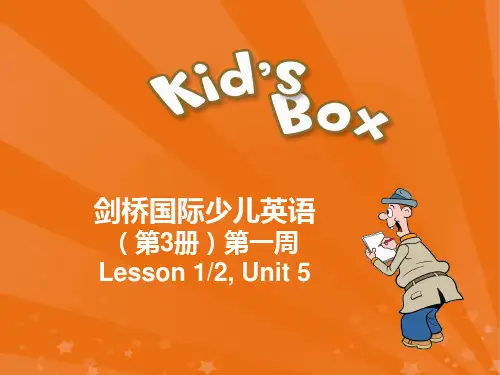
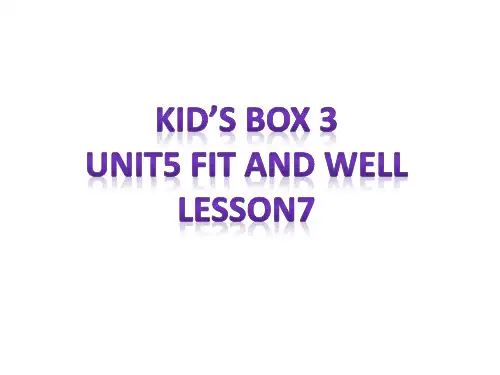
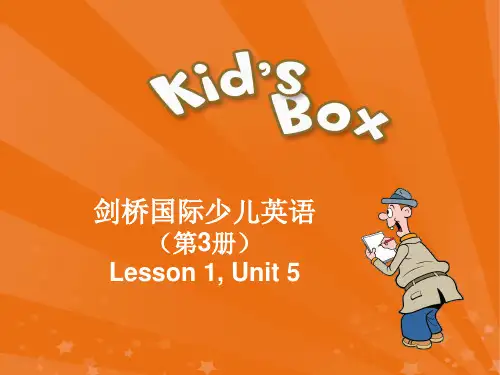
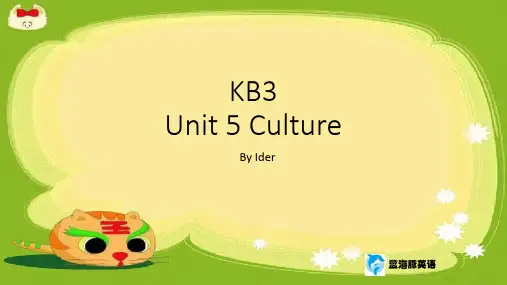
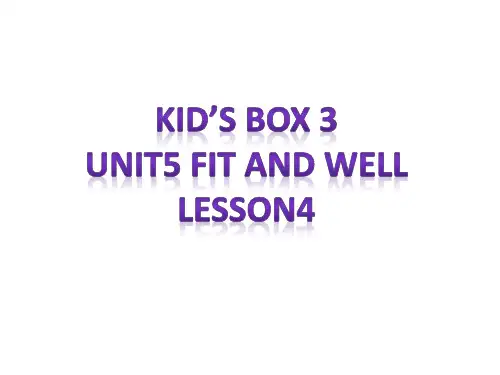
剑桥国际少儿英语3第五单元lock and keyThe intricate dance between locks and keys has been a captivating part of human history for centuries. These seemingly simple mechanisms have played a vital role in securing our most prized possessions, safeguarding our privacy, and shaping the way we interact with the world around us. In this essay, we will delve into the fascinating world of locks and keys, exploring their evolution, their significance, and the myriad ways in which they have become woven into the fabric of our lives.Locks and keys have a long and storied history, dating back to ancient civilizations. The earliest known lock and key system was discovered in the ruins of the ancient Egyptian city of Nineveh, dating back to around 4000 BC. These primitive devices were made of wood and consisted of a bolt that could be secured by a wooden pin tumbler lock. As civilizations advanced, so too did the complexity and sophistication of lock and key systems.Throughout the ages, locks have been crafted from a variety of materials, each with its own unique properties and applications. Fromthe sturdy iron locks of medieval castles to the delicate pin tumbler locks of modern-day homes, the evolution of these devices has been a testament to human ingenuity and the constant drive to create more secure and reliable means of protection.One of the most significant advancements in lock technology came with the invention of the pin tumbler lock, attributed to the ancient Egyptians. This design, which utilizes a series of pins of varying lengths to prevent the bolt from opening without the correct key, has remained a fundamental component of many modern lock systems. As technology has progressed, lock designs have become increasingly complex, incorporating features such as electronic sensors, biometric identification, and even wireless connectivity.Alongside the development of locks, the creation of keys has also been a crucial aspect of this enduring story. Keys, too, have evolved from their humble beginnings as simple wooden or metal devices to the sophisticated, high-tech tools we use today. From the intricate warding and bitting patterns of traditional keys to the advanced radio-frequency identification (RFID) chips found in modern keyless entry systems, the key has become a symbol of access, control, and trust.The significance of locks and keys extends far beyond their practical applications. These humble devices have become cultural icons,representing themes of security, privacy, and personal identity. In literature and art, locks and keys have been used as metaphors for the human condition, exploring themes of trust, vulnerability, and the search for personal fulfillment.One particularly poignant example can be found in the works of renowned author Ernest Hemingway. In his novel "The Sun Also Rises," Hemingway uses the imagery of a locked suitcase to symbolize the emotional barriers and personal struggles faced by the characters. The suitcase, with its key held by a distant lover, becomes a tangible representation of the characters' inability to fully connect with one another, highlighting the universal human desire for intimacy and understanding.Similarly, in the realm of art, locks and keys have been the subject of countless works, from the intricate etchings of Albrecht Dürer to the surreal sculptures of Salvador Dalí. These artistic interpretations have further cemented the symbolic significance of these everyday objects, inviting viewers to explore the deeper meanings and emotional resonances that they evoke.Beyond their cultural significance, locks and keys have also played a crucial role in the practical aspects of our lives. From the simple padlocks securing our bicycles to the high-security systems safeguarding our most valuable assets, these devices have becomean integral part of our daily routines and the infrastructure that supports our modern world.In the realm of security, the importance of locks and keys cannot be overstated. They have become essential tools in protecting our homes, businesses, and vital information from the prying eyes of those who seek to do us harm. The continuous advancements in lock technology have led to the creation of increasingly sophisticated systems that utilize biometric data, encrypted codes, and even cloud-based access management to ensure the safety and privacy of our most sensitive belongings.Furthermore, the use of locks and keys extends beyond the realm of personal and commercial security. In the world of transportation, these devices have become vital components in securing everything from vehicles to shipping containers, ensuring the safe and efficient movement of people and goods around the globe. The development of advanced key technologies, such as keyless entry systems and remote-controlled locks, has revolutionized the way we interact with our modes of transportation, providing greater convenience and security.Looking to the future, the role of locks and keys is poised to evolve even further. As the world becomes increasingly connected through the Internet of Things (IoT), the integration of smart locks and digitalkeys is expected to transform the way we access and secure our homes, workplaces, and even entire cities. Imagine a world where a single digital key, stored securely on your smartphone, could grant you access to your front door, your office, and your car, all with a simple tap or voice command.This vision of a seamlessly connected future is not merely a fanciful dream, but rather a tangible reality that is rapidly taking shape. As technology continues to advance, the humble lock and key are set to play an even more vital role in shaping the way we live, work, and interact with the world around us.In conclusion, the story of locks and keys is a testament to the enduring ingenuity and adaptability of the human spirit. From their ancient origins to their modern-day applications, these unassuming devices have become a fundamental part of our lives, safeguarding our most prized possessions, securing our personal and collective safety, and serving as powerful symbols of trust, privacy, and personal identity. As we look to the future, the continued evolution of locks and keys will undoubtedly continue to shape the way we navigate the world, opening doors to new possibilities and forging ever-stronger connections between ourselves and the spaces we inhabit.。
2.Listen and check.Aunt May: Good morning. How are you today, Stella?Stella:Oh, I’m not very well. I’ve got a cold.Aunt May: And you’ve got a cough. Have you got a headache.Stella:Oh, yes! My head hurts a lot, and I’m very hot.Aunt May: OK. Put this under your arm. Oh, yes. 39 degrees. You’ve got a temperature. So you must drink lots of water and orange juice. Now, what’s the matter with you, Simon?Simon: My stomach hurts a lot. I don’t want to eat.Aunt May: Have you got a toothache?Simon: No.Aunt May:I see, so…you’ve got a stomach-ache. Well, go to bed anddon’t eat any cake, sweets or chocolate today.Simon:Oh, I think I’m Ok now. Can I go and play?Aunt May:Hmm…3.Listen and do the actions.You’ve got a headache. You’ve got a temperature. You’ve got a toothache. You’ve got a stomach-ache. You’ve got a cough. You’ve got a cold.4.Listen and say the letter.Girl: What’s the matter?Boy:Oh, I’ve got a headache. ( h )Boy:What’s the matter with you?Two girls:We’ve got colds. ( g )Man:What’s the matter with him?Girl:He’s got a cough. ( c )Man:What’s the matter with them?Girl:They’ve got a temperature. ( b )Woman:What’s the matter with your grandfathe r? Boy:He’s got a backache. ( e )Woman:What’s the matter with your dad?Boy:He’s got a toothache. ( f )Man:What’s the matter with your grandmother? Girl:She’s got a stomach-ache. ( a )Woman:What’s the matter with your sister?Boy:He’s got an earache. ( d )8. Listen and check.Grandpa: Oh, dear. What’s the matter with Stella?Mrs Star: Hmm. She’s got a temperature. Look, 39 degrees! Stella: Can I go to school, Mum?Mrs Star: No, you can’t go to school today.Grandpa: Go to school! She mustn’t go out!Stella: Can I get up?Mrs Star: No, sorry. You mustn’t get up.Grandpa: You must stay in bed and put this blanket on you. Stella: Can I read?Mrs Star: Yes, you can read. And you must take this. Grandpa: Oh, how often must she take it?Mrs Star: She must take it after every meal for a week.Stella: A week?...Oh, no!11. Listen and complete the sentences. Say ‘must’ or ‘mustn’t’.1. When you’ve got a cough you (mustn’t) go out.2. When you’ve got a temperature you (mustn’t) go to school.3. When you’ve got a backache you (mustn’t) do sport.4. When you’ve got a headache you (must) go to bed.5. When you’ve got an earache you (mustn’t) listen to music.6. Whe n you’ve got a stomach-ache you (mustn’t) eat sweets.7. When you’ve got a toothache you (must) go to the dentist.8. When you’ve got a cold you (must) drink a lot of orange juice.12. Listen and repeat. Point to the picture and say the sound.1. phone2. fruit3. hot4.goat5.who6.clothes7. cross 8. doll 9.clock 10. no 11. move 12. boat13. juice 14. you 15. nose 16. slow。
剑桥少儿英语Kid’s Box 5 教学大纲
Unit3-5
单元 重点语言 重点词汇 语音
Unit3
City of life
描述方向的句子,祈使句,如何描述图片 方向词:right; left;
straight on;corner; past;
across;along;turn;traffic
lights; at the end of; police
station; Scotland yard;
theater; play; post office;
hotel; airport; restaurant;
museum; castle; prison;
black cab
[ʌ]
Unit4 Disaster 一般过去时,过去进行时,序数词,月份,最高级 Disaster;storm; island; catch fire; feel ill; iceberg; lightning; striped; tights; volcano; liquid rock; gas; earthquake; destroy; dangerous; 月份词
弱读
形式
Unit5 Material Made of, made from, come from,描述物体 Brick; chocolate; sugar;
fur; bone; wood; hair; rock;
plastic; manmade; factory;
natural; wool; recycle;
metal; minerals; special; mouse/mice; the ground; sand; bear; palace; watchdog 同音异形异义词 Wood
Would;
No
know